A Game of Polo with a Headless Goat tends to intrigue students immediately with its strange title – odd images that don’t match up. This is one of the more light-hearted and fun extracts from the Edexcel GCSE/IGCSE English Language Paper 1 Section A: non-fiction texts, so always a pleasure to teach. This is a guide to teaching the text based on my A Game of Polo with a Headless Goat GCSE Resources.
The author of the book Emma Levine, a travel writer and photographer, admits that her life, like the title of her book, “has taken an unconventional route.” She has explored and written about various sports around the world, and A Game of Polo with a Headless Goat is no exception.
It’s exciting with and undertone of danger, full of suspense and risk; but how can we support students to capture that in their exam essays? How can we break it down to consider not only the message from a critical stance, but how Levine conveys the exciting yet hazardous atmosphere of the donkey race through multiple language and structural techniques?
Teaching Ideas for A Game of Polo with a Headless Goat Edexcel GCSE
I’ve created a resource for busy teachers to take you step-by-step through A Game of Polo with a Headless Goat, from an engaging, thought-provoking starter, to identifying language techniques, to analysing and annotating the text, to practising Edexcel GCSE style questions on the text, including a comparison to another GCSE text, A Passage to Africa. This resource contains editable Google slides, quizzes with answer keys, exam questions, techniques and model answers and close textual annotations of the whole text
Edexcel IGCSE English Language Paper 1 Exam Structure
The 2 hour 15 minutes Edexcel IGCSE English Language Exam is split into Section A and Section B. Section A is the reading assessment and candidates are presented with one of the 10 Anthology non-fiction texts and one thematically linked unseen text. They have 5 questions to answer in Section A:
- A 2 -mark retrieval question. Lifting and copying two brief and relevant quotes from the unseen text is the skill being assessed in this question.
- A 4-mark summary question. Candidates are asked to paraphrase a certain event, character or theme from the unseen text.
- A 5-mark ‘SQUID’ question (it’s an acronym not a slimy sea creature!). Students identify five distinct details from the unseen text and use quotations to support their points.
- A 12-mark extended analytical response on the seen text.
- A 22-mark comparative essay, usually based on the writers’ perspectives, experiences or feelings.
Section B is a writing assessment. Candidates choose between two options, which are normally loosely based on the Section A texts. The text types include a letter, article, speech or leaflet. Both Section A and Section B are equally weighted, worth 45 marks each.
A Game of Polo with a Headless Goat Starter Activity
The title is a crucial part of this extract as it contains a juxtaposition between two contrasting images. However, some students, especially those in international schools and English as a Second Language pupils, may not have the cultural reference point to decode this independently. That’s why it’s useful to ensure that students understand the dichotomy of the title and how it relates to the central theme – the excitement and danger of the donkey race.
I first ask students to make predictions based on the book cover and title, then we discuss as a class. The unusual title is normally enough to pique their interest. I have often had to elicit connotations of the ‘game of polo’ with the upper class and wealth in international settings, and I often get humorous comments about the ’headless goat’. The important message I attempt to instil at this point is the stark contrast in the title, which is developed in the text through contrasts in the atmosphere and the writer’s perception of the foreign culture.
I also briefly introduce students to Emma Levine and what she does – although context is not assessed in this English Language Paper, it gives students an idea of what genre the text will be and the potential tone and purpose of the writer.
A Game of Polo with a Headless Goat Language and Structure Techniques
Before diving into the text, I quickly review key language techniques in the extract so that they are fresh in students’ minds as they read. Included in this resource is a matching activity –the name of the technique with the definition – to use as a refresher. Students can either copy, cut and paste or simply number the language techniques. As an extension, students can write their own examples of the literary devices.
A Game of Polo with a Headless Goat Annotations
Before close textual analysis, I often ask students to do an initial reading with 2 different coloured highlighters. They highlight language which illustrates the fun and exciting atmosphere of the plot in one colour and danger and tension in another colour. It is a fairly straightforward extract for students to understand on a surface level – being a spectator at a donkey race which does not have a clear winner, leading to disagreement over bets placed on the race. The more challenging skill comes in unpacking how Levine experiences and portrays this foreign culture and how others relate to her as an outsider visiting an area in which few tourists likely venture.
When it comes to closely analysing the text of the extract, there are a few ways of approaching the activity. You can read and annotate together with students completing the annotations in real time. Alternatively, you can split students into groups and ask each group to focus on a certain paragraph before feeding back to the class. Or you could read and discuss, then ask students to complete the annotations for homework.
There are many ways of approaching close textual analysis; I find that varying the method for different texts keeps students interested through the unit. Detailed annotations of language and structural techniques are included in this A Game of Polo with a Headless Goat GCSE/IGCSE lessons and activities.
For this text, I model how to closely annotate the first section of the text, then split the class into small groups and give them a section each to analyse. Questions for each group have been included in the resource. To share the annotations, you can either have students present to the class or conduct some variation of jigsaw activity in which each group nominates 1 or 2 students to rotate and ‘teach’ the other groups about their section. When they return to their ‘home’ group, the students who remained and were ‘taught’ now ‘teach’ the students who rotated about the sections they missed.
This enables much peer interaction and opportunities for information to become embedded, plus limits boredom from repeated annotation lessons. If you are concerned that students will miss crucial information in peer discussion and annotation, you could give them teacher notes and ask them to ‘fill in the gaps’ for homework.
Edexcel GCSE/IGCSE English Language Paper 1 Exam Questions 2 and 3
After analysing the text, I do a quick AFL multiple choice quiz with students to assess their understanding of the language and structure of the text, then introduce exam practice questions. Quiz questions and answers are available with these A Game of Polo with a Headless Goat GCSE resources. This can be done as a whole class activity on the interactive whiteboard or handed out to students to do in pairs or individually, depending on your time and the nature of your class.
Questions 2 and 3 on the Edexcel IGCSE English Language Paper 1 test students’ understanding of the unseen text, whereas question 4 assesses analysis and evaluation of the previously studied text. When you teach the 10 non-fiction texts, it’s useful to ask them questions in the style they will encounter on the exam, but for the text studied. That way, you can teach the structure, rubric and help students to plan and write quality responses AND learn the set texts deeply. You have time for self and peer assessment as well as model answers. I usually teach 1-3 of the questions per text. Over the span of studying all 10 texts, students will cover all question types from the language exam. At the end of the unit (or throughout time-permitting), I ensure they do a past paper and respond to the questions based on an unseen text.
For A Game of Polo with a Headless Goat, I have written questions that are structured similarly to questions 1, 2 and 3 from the language paper and a framework for students to structure their answers, as well as model answers for them to use to either self or peer-assess. I find peer assessment works particularly well for questions 1, 2 and 3 of the language paper (the lower stakes questions worth fewer marks). Students gain confidence marking these shorter answers which they can then apply to assessing the longer responses.
Comparative 22-mark Edexcel GCSE English Language Paper 1 Question 5
For this text, I also introduce students to Question 5 on the English Language Paper 1 – the 22-mark comparative essay. In the exam, students compare the studied set text to an unseen text, which is usually thematically linked to the text studied in class. If you are teaching all 10 texts and have a limited time, you can ask students to compare to one of the set texts before you study it in detail. I find that A Game of Polo with a Headless Goat compares well with A Passage to Africa. Both are travel pieces but have contrasting tones and subject matter which can be discussed in a comparative essay.
I first give students the question of focus, but before asking them to answer it, I go through the rubric. You could ask students to highlight key words or identify skills required to achieve top marks for this question. Then, ask students to complete a comparison table after simply reading the A Passage to Africa text (not studying it in detail yet to mimic the exam), making notes identifying similarities and differences between the texts. It’s useful for students to do a brief condensed version of this process in the exam. I have included an editable template with key comparisons in the resource pack.
Once they have done the notes in pairs or independently, take feedback. Students could complete this digitally then combine notes on a shared document or platform if your situation enables digital interaction between students (sharing a document on Teams for example). Now, students have generated ideas to write in their comparative essay, I share an example of how to construct an effective comparative paragraph. As an examiner, I see many superficial and unorganised comparisons, which reduce students’ marks. Teaching a paragraph formula can help students construct cohesive essays.
Edexcel GCSE/IGCSE English Language Paper 1 Question 5 Model Answer
A big part of comparative writing is connecting ideas. I have included a quick connective activity to compile a variety of comparison and contrast connectives so that students have a range of ‘signposts’ for their ideas available to them in their ‘exam toolkits’. When that quick activity is done (answers included in the resource pack), students can actually write their answers. Giving them a framework and collective idea generation enables them to write higher quality answers straight away.
There is also a full-mark response included which I would recommend sharing with students when they have finished their pieces, either to use to peer assess or after you have marked as a model standard. The essay included with this resource is more extensive and detailed than what students would need to produce to be awarded full marks for this task at GCSE level.
If you want to share the whole thing with them to give an idea of different ideas that could be included in an answer for this question, that would be just as effective as cutting out certain parts and presenting them with half of it. Either way, the resource is editable and adaptable to what you feel your students are capable of.
Edexcel GCSE English Language Paper 1 Transactional Writing Practice
There is also a couple of creative activities included in this resource. Time-permitting, you could use it as a class activity if you feel that students aren’t connecting with the text, as a homework assignment or an extension activity to challenge students to broaden their perceptions of the text. For A Game of Polo with a Headless Goat, there is an option between writing a newspaper article and a creative piece. This can help develop skills required for Section B of Paper 1 (Transactional Writing) and Section B of Paper 2 (Imaginative Writing).
Game of Polo with a Headless Goat Teaching Resources Edexcel GCSE English Language
To sum up, some of the best techniques for teaching the 10 non-fiction texts include:
- Hook students with an intriguing starter activity
- Use alternative methods to closely analyse and annotate the text
- Quiz students for quick AFL strategy to assess whether they are engaging with the text
- Practise either questions 1-3, question 4 or question 5 from the Language paper
- Study model answers, including examples of typical mistakes students make in the exam responses
- Offer an optional creative activity as homework or an extension to challenge students’ perceptions of the text
Good luck teaching A Game of Polo with a Headless Goat – it’s exciting and unusual so interesting to teach in so many ways. Comment below if you can add any useful teaching and learning techniques for this text.


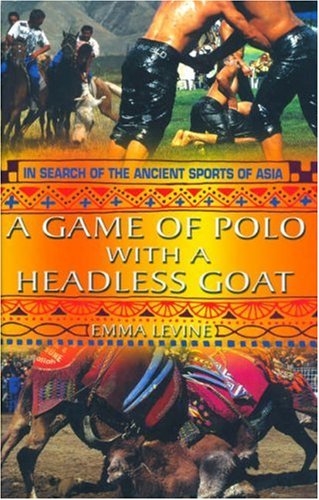
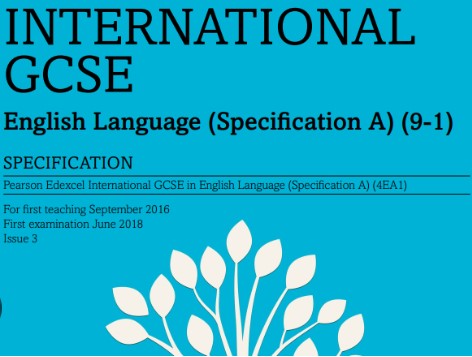
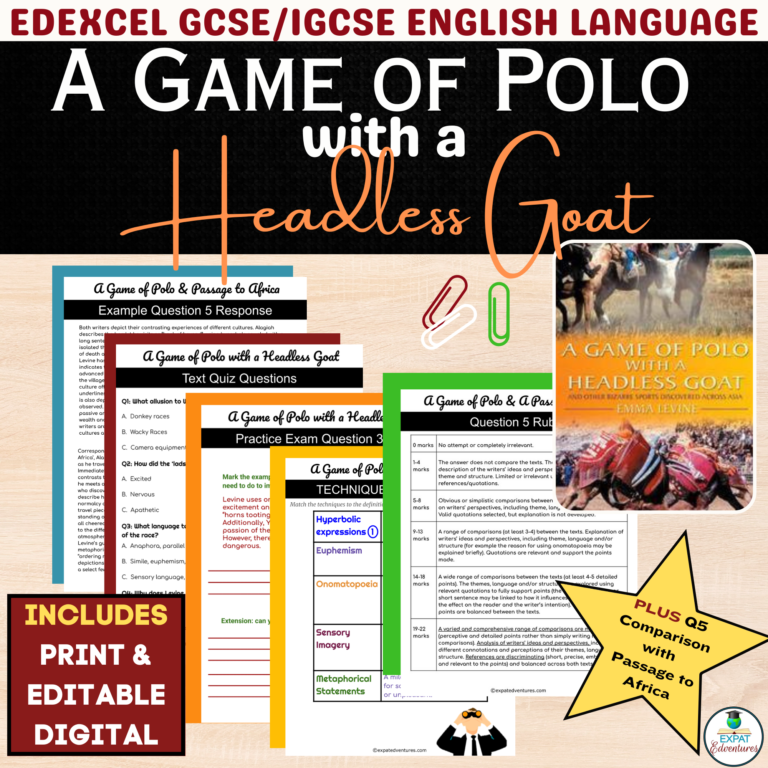

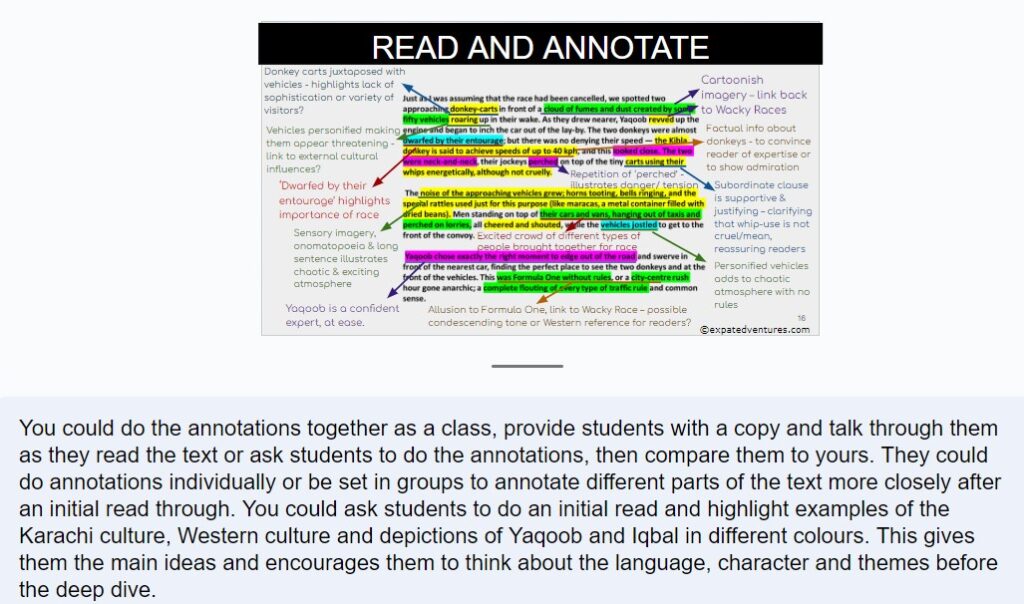
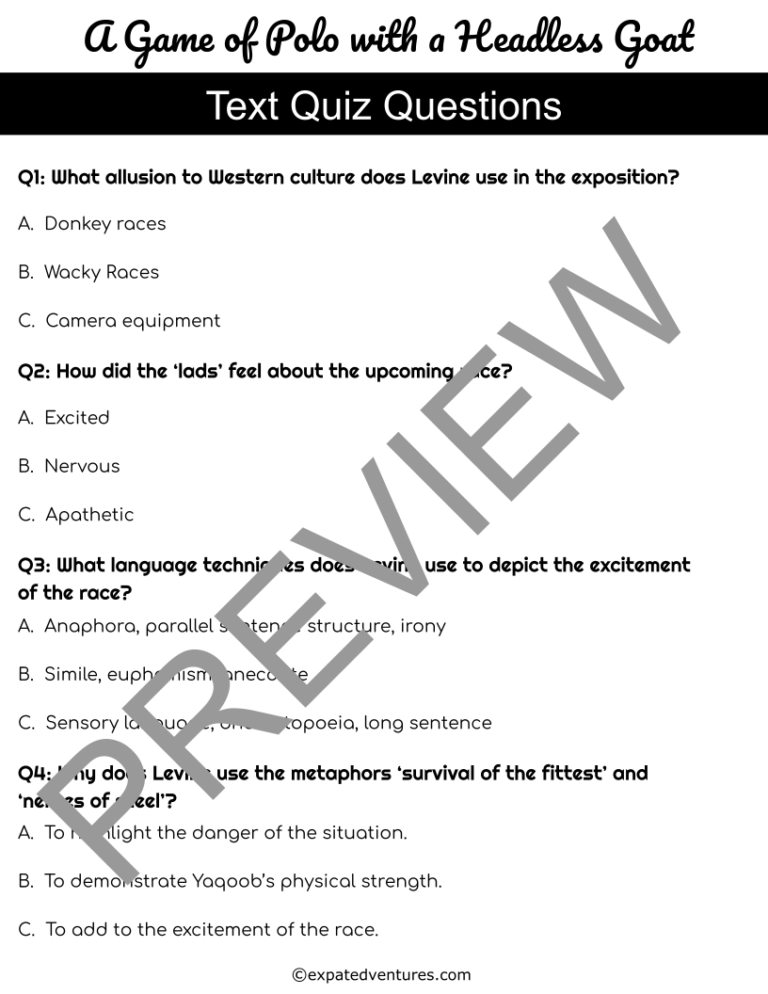
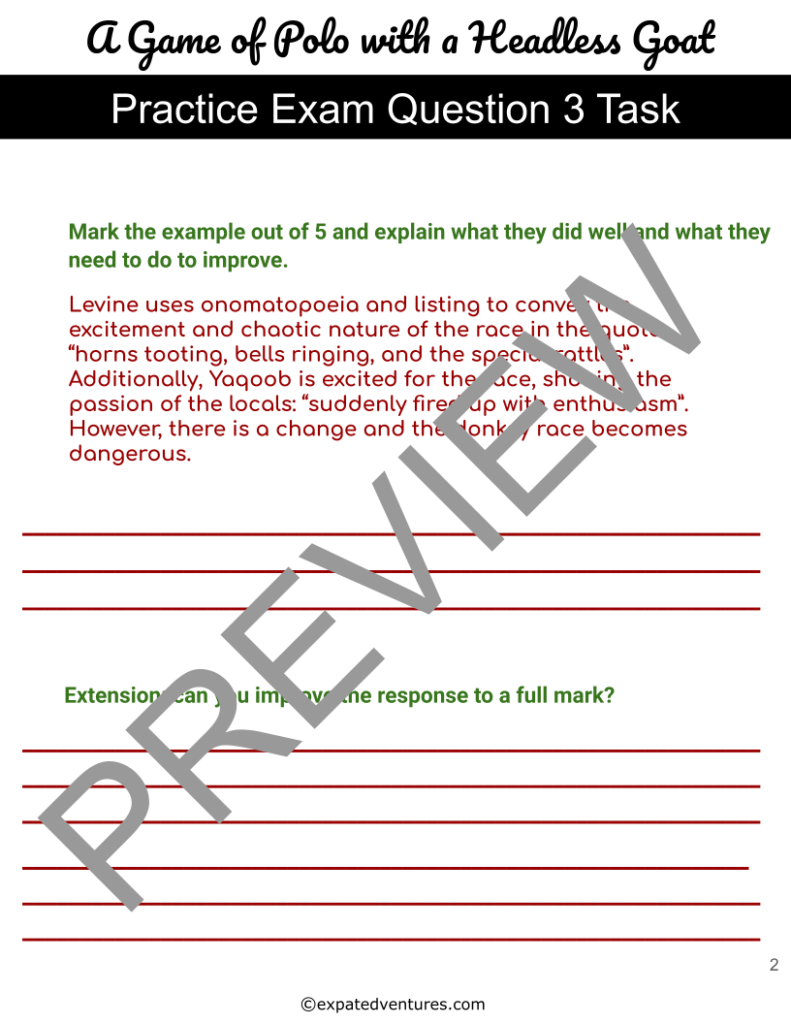
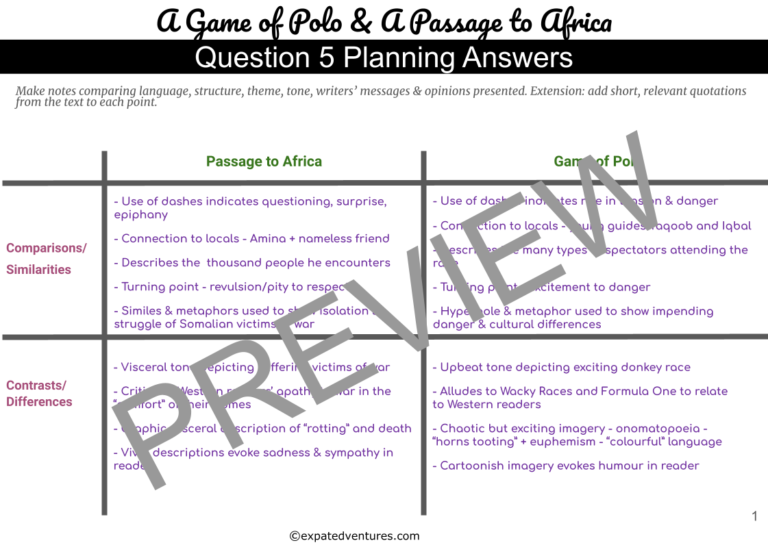
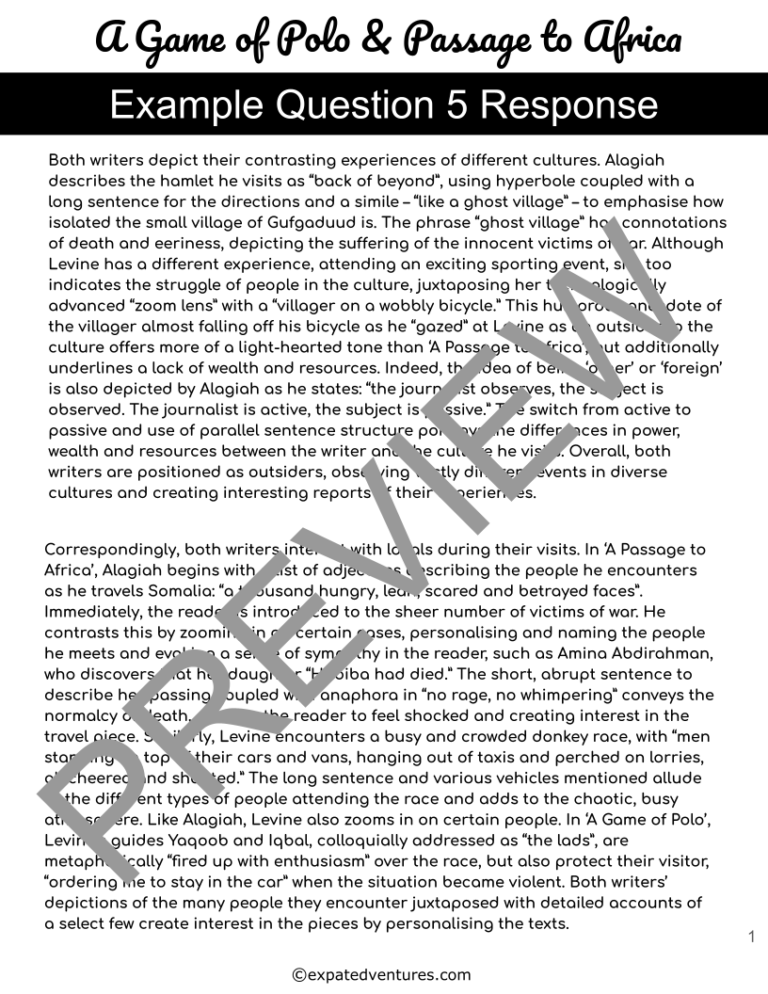
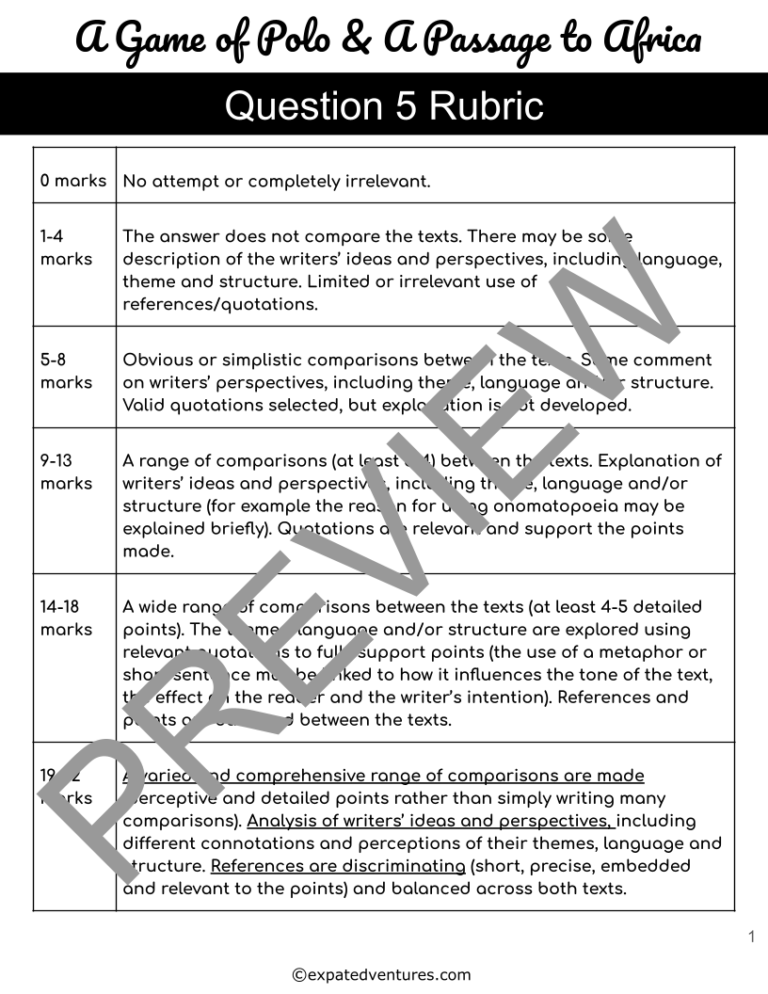

Pingback: A Passage to Africa GCSE & IGCSE Activities and Resources - Expat Edventures